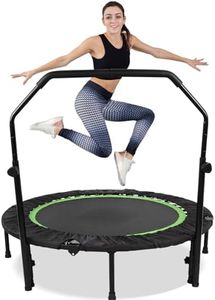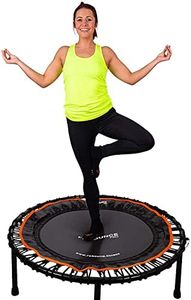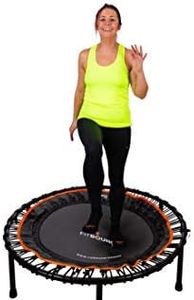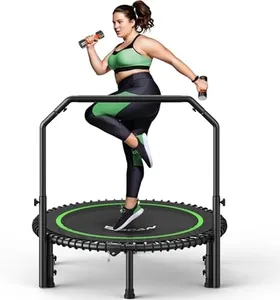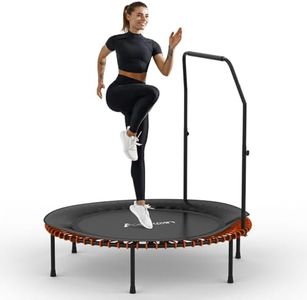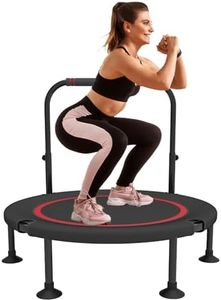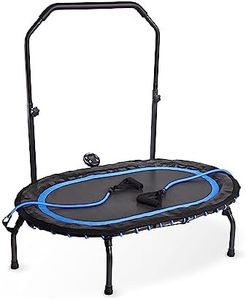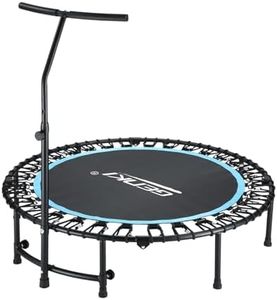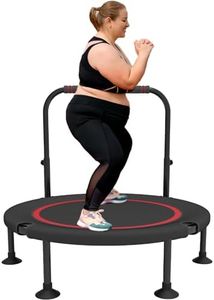We Use CookiesWe use cookies to enhance the security, performance,
functionality and for analytical and promotional activities. By continuing to browse this site you
are agreeing to our privacy policy
10 Best Mini Trampoline For Adult
From leading brands and best sellers available on the web.Buying Guide for the Best Mini Trampoline For Adult
Choosing the right mini-trampoline for adults can be a fun and rewarding process, as these exercise tools offer great benefits for cardiovascular fitness, balance, and muscle toning. When looking for the best fit, it's important to think about your fitness goals, how much space you have, and how intensively you plan to use the trampoline. By understanding key features and how they relate to your needs, you can make sure you pick a model that is comfortable, safe, and long-lasting.Weight CapacityWeight capacity refers to the maximum weight the trampoline can safely hold. This is crucial for safety—using a trampoline not designed for your weight can lead to damage or injury. Trampolines are usually divided into capacities such as under 200 lbs, 200-300 lbs, and over 300 lbs. Choosing the right one depends on your own weight or the heaviest person who will use it; always pick a trampoline with a weight limit higher than your weight to ensure both durability and safety.
Mat SizeThe size of the jumping mat determines how much room you have for exercise routines. Smaller mats (around 36-38 inches) are more compact and space-saving, making them ideal if you have limited space or prefer light bouncing. Medium sizes (around 40-44 inches) offer a balance between roominess and ease of storage, while larger mats (45 inches and above) provide extra space for more extensive exercises like jogging in place or side-to-side movements. Consider the exercises you plan to do and the space in your home when picking the mat size.
Spring or Bungee SystemMini-trampolines use springs or bungee cords to provide the bounce. Springs usually give a firmer, higher bounce and may feel more traditional, but can be noisier. Bungee cords are quieter and offer a softer, smoother bounce, which is easier on the joints. Lighter users, people with joint concerns, or those seeking quiet operation may prefer bungee systems, while people interested in a firmer workout might lean toward spring systems. Think about your comfort, noise sensitivity, and desired workout intensity when making this choice.
Handlebar AvailabilitySome mini-trampolines come with attachable handlebars, which provide extra stability and balance during workouts. This feature is particularly supportive for beginners, older adults, or those doing balance-challenging exercises. Handlebars also help if you feel uncertain about jumping freely. If you value extra safety or want to try faster or more dynamic routines, look for a model with an adjustable and sturdy handlebar.
Portability and StorageThis refers to how easy it is to move and store the trampoline. Foldable trampolines or those with removable legs can be packed away after use, making them great for smaller spaces or if you don’t need the trampoline out all the time. Non-folding designs tend to be sturdier but may require a dedicated spot in your home. Consider your available space and whether you'll need to move or store your trampoline often.
Surface MaterialThe material of the jumping mat affects durability, comfort, and safety. Common materials include polypropylene and other woven fabrics, which are both strong and resilient. Higher-quality surfaces provide better grip and comfort for your feet, and they last longer, especially with regular use. If you plan on vigorous workouts or daily use, a trampoline with a high-quality, tear-resistant mat is a valuable choice.
